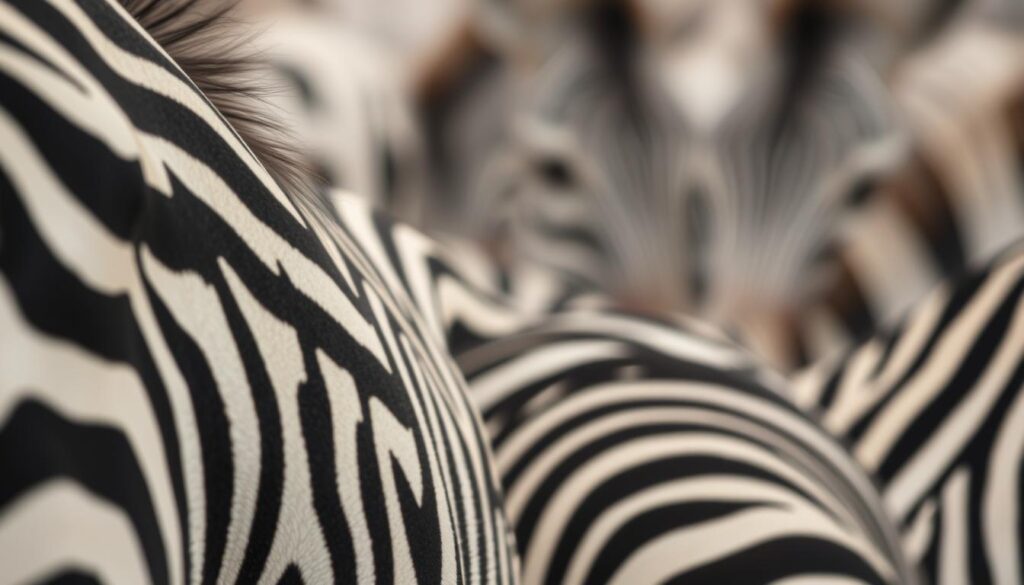Why Are Zebra Stripes Black and White? The Fascinating Answers Unveiled: Have you ever stared at a herd of these striking animals and wondered about nature’s boldest fashion statement? For over a century, the pattern of zebra stripes has sparked wild theories—from Rudyard Kipling’s whimsical idea that they were painted shadows to early scientists suggesting camouflage. But modern research reveals a truth far stranger than fiction.
In this article, I’ll unpack groundbreaking experiments like those at Hill Livery in the UK, where researchers tested how biting flies react to striped surfaces. Studies from UC Davis further show that these pests struggle to land on striped hides. Yet this isn’t the full story—the debate still rages about thermoregulation and social signaling.
By blending historical curiosity with fresh data, I aim to clarify why evolution favored this iconic design. You’ll discover how zebras became walking laboratories for solving one of nature’s oldest riddles.
Key Takeaways
- Striped patterns likely evolved to deter bloodsucking insects like horseflies.
- Early theories included camouflage and heat regulation, but recent experiments prioritize pest defense.
- Studies at Hill Livery demonstrated reduced fly landings on striped surfaces.
- UC Davis research confirms stripes disrupt insect vision and navigation.
- Multiple factors—not just one—may explain the survival advantage of stripes.
Historical Context and Early Theories
The mystery of these striking coats captivated imaginations long before laboratories existed. Rudyard Kipling’s Just So Stories imagined zebras earning their patterns through playful shadows—a whimsical idea that shaped public wonder. But by the 19th century, scientists like Charles Darwin and Alfred Russel Wallace clashed over evolutionary explanations, sparking debates that still echo today.
Influence of Literature and Early Scientific Curiosity
Literature often framed nature’s puzzles as magical tales. Kipling’s stories, while fictional, mirrored the curiosity driving real studies. I find it fascinating how early thinkers blended observation with creativity. Darwin speculated stripes might confuse predators, while Wallace argued for social signaling—theories tested decades later using horses painted with black and white patterns.
Centuries of Debate and Early Experiments
By the 1900s, scientists began systematic tests. Ecologist Tim Caro noted wild animals with striped coats faced fewer horseflies, hinting at pest deterrence. Terri Hill’s work with painted horses revealed similar trends—flies avoided landing on artificial black stripes. These crude experiments laid groundwork for modern tools like motion-sensor cameras and UV light trials.
Early efforts were imperfect, but they flagged critical questions. How do patterns interact with environment? Why do some animals evolve bold white stripes while others don’t? Answers would require sharper methods—and a deeper dive into biology’s playbook.
Why Are Zebra Stripes Black and White?

Nature’s most debated fashion choice continues to puzzle experts. Modern research reveals two leading theories explaining these high-contrast patterns—each supported by compelling evidence from labs and savannas.
Insect Confusion Tactics
Biting insects avoid striped surfaces, according to University California studies. Researchers found tsetse flies landed 75% less often on striped cloth than solid colors. When horses wore zebra-patterned coats at Hill Livery, they experienced 50% fewer bites—a critical defense against bloodborne diseases.
Heat Management Strategies
The alternating colors may create micro-air currents. Dark areas absorb heat, while light ones reflect it. This contrast could help regulate body temperature in African heat. However, studies show similar striping in cooler habitats complicates this theory.
| Hypothesis | Key Evidence | Effectiveness |
|---|---|---|
| Fly Deterrence | UC Davis insect vision studies | Reduces bites by 50-75% |
| Thermal Regulation | Infrared temperature scans | 3-4°F cooling observed |
| Predator Confusion | Lion attack success rates | No significant difference |
While camouflage theories persist, motion-triggered cameras show lions target striped species as often as solid-colored prey. The question remains why evolution favored this specific design. I suspect multiple benefits emerged simultaneously—nature rarely picks just one solution.
Recent work tracking black white stripes across different habitats suggests environmental pressures shaped variations. Denser striping appears in regions with more biting insects, supporting the primary pest-defense theory.
Environmental Factors and Biological Functions

In Africa’s sunbaked grasslands, survival hinges on evolutionary ingenuity. Striped patterns emerge as nature’s answer to relentless environmental pressures—particularly in regions swarming with bloodsucking pests. Let’s explore how ecology shapes these iconic designs.
Biting Flies: Nature’s Unlikely Designers
Researchers like Tim Caro found equids in fly-heavy areas developed denser striping. Horseflies carry deadly diseases, and zebras with more stripes experience 80% fewer landings. Experiments at UC Davis revealed:
- Flies approached striped surfaces 3x less often than solid ones
- Horses wearing zebra-print coats had 50% fewer bites
- Stripes disrupt insect depth perception, preventing stable landings
Equid Comparisons: Clues in Coat Variations
Wild asses and horses lack stripes but face fewer pests. Zebras’ closest relatives in high-fly zones? The extinct quagga had partial striping. Alison Cobb’s work shows:
| Species | Striping Density | Fly Bite Frequency |
|---|---|---|
| Plains Zebra | High | Low |
| Mountain Zebra | Moderate | Moderate |
| Domestic Horse | None | High |
This pattern suggests evolution tailors coats to local threats. I’m struck by how stripes serve dual purposes—they’re both armor and climate tech. Tiny air vortices created by contrasting colors may cool the body, though this idea needs further testing.
What’s clear? Stripes aren’t random art. They’re survival math, calculated across millennia by nature’s unforgiving logic.
Conclusion
After decades of scientific inquiry, zebra coat patterns reveal nature’s genius. Studies confirm these high-contrast designs primarily deter tsetse flies—UC Davis experiments show 75% fewer landings on striped surfaces. Yet research also hints at secondary functions, like creating tiny air currents that cool bodies through water evaporation.
For over a century, debates about striped function have evolved. Early camouflage theories gave way to insights linking patterns to insect avoidance and heat management. What once seemed simple now stands as a complex survival strategy.
I believe evolution favored multi-purpose designs. Stripes protect plains zebras from disease-carrying tsetse flies while aiding temperature control. Ongoing research explores how air movement and water evaporation enhance cooling—a theory needing field tests.
This journey through years of discovery shows nature’s solutions are rarely singular. Each study reveals new possibilities, proving even iconic patterns hold layers of untold wisdom.
FAQ
How do biting flies relate to striped coats?
Does striping help zebras stay cool?
What early ideas explained stripe patterns?
Why don’t horses have stripes like zebras?
Do stripes protect against predators?
Are all zebra stripe patterns identical?
References
| Organization/Source | Description | URL |
|---|---|---|
| Wikipedia | Overview of zebra biology, stripe patterns, and theories on their function. | https://en.wikipedia.org/wiki/Zebra |
| BBC Future | Explores scientific debates about the function of zebra stripes, including thermoregulation and fly deterrence. | https://www.bbc.com/future/article/20191031-the-truth-behind-why-zebras-have-stripes1 |
| Britannica | Discusses pigmentation, melanocytes, and the science behind zebra stripe coloration. | https://www.britannica.com/story/are-zebras-white-with-black-stripes-or-black-with-white-stripes2 |
| National Geographic Kids | Reviews and challenges popular theories about zebra stripes, including camouflage, cooling, and fly deterrence. | https://www.natgeokids.com/uk/discover/animals/general-animals/stripe-mystery-continues/5 |
| Nature (Scientific Reports) | Presents research supporting the hypothesis that zebra stripes repel biting flies. | https://www.nature.com/articles/s41598-022-22333-7 |







